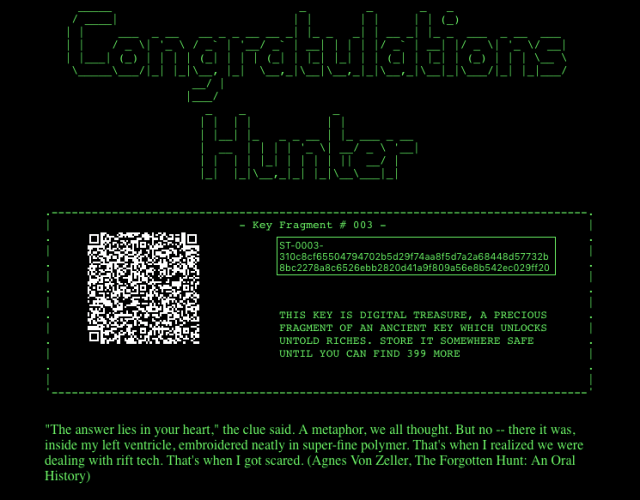It began with an encrypted message transmitted through the Blockstream Satellite on April 13.
“Welcome, Hunter,” it began. “If you are reading this, something has led you to search for things which bring excitement to an otherwise predictable world.” This was the first clue in Satoshi’s Treasure, a global game that spans both digital and physical realms—sort of like a cross between a cryptographic puzzle and geocaching. For those who complete the game (people are encouraged to work as “clans”), $1 million worth of bitcoin awaits.
To solve the puzzle, people have to reassemble a secret key that’s been divided into 1,000 parts. Players need only find 400 of the pieces to unlock the treasure “using Shamir’s spell.” Shamir likely refers to Adi Shamir, an Israeli cryptographer who coinvented the RSA algorithm, which is named after its creators, Rivest–Shamir–Adleman. It’s an asymmetric cryptosystem featuring a public and private key to securely send information (sound familiar?). Shamir is also behind a “secret sharing” algorithm, where a secret is divided up and a minimum number of those parts is needed to reconstruct it. This describes the last step of acquiring Satoshi’s Treasure.
This isn’t the first time bitcoin enthusiasts have been offered a digital currency prize for solving a puzzle. Artists painted one in 2015 whose solver would get $50,000 worth of bitcoin (it was solved three years later). A mural painter in Paris also hides the keys to bitcoin wallets in his street art.
The full team behind Satoshi’s Treasure isn’t known. Its cocreator Eric Meltzer, founder of Primitive Ventures, told Coindesk that Zcash cocreator Ian Miers was involved with the planning (but not in clue creation), along with 18 others. However, no central entity will give the bitcoin treasure to the winners when the game is up. Those players will be able to unlock it themselves when they solve the puzzle.
That’s the background. Here’s what gone down since the game was introduced.
The first three keys are out.
Distributed via Blockstream’s satellite, the first three keys are listed as The Jade Key, The Bismuth Key, and Mamoru’s Key. “These locations can be discovered by monitoring the output of the primitive orbitals known in your time as GALAXY18, EUTELSAT 113, TELSTAR 11N, and TELSTAR18V at 1 p.m. EST, April 14 in the year 2019,” reads the clue.
Someone already solved the first three keys.
A Twitter user called John Cantrell posted his process for obtaining the three key shards on Github. QR codes released in several cities led to a website asking players to enter a “passphrase.” Since those QR codes were surrounded by the word “orbital,” Cantrell used that as the passphrase, and it worked. He got the first piece of the key.
From there, Cantrell saw that the passphrases for the two additional keys were hidden in the Satoshi’s Treasure website’s source code. Using a Ruby script and an English language dictionary (he assumed the other passphrases would also be in English), Cantrell ultimately discovered the words he needed to obtain keys two and three—“cosmos” and “blackhole.” Looks like we’re seeing a theme, here.
The congratulations page you arrive at after typing in the passphrase for the third key fragment.

About 20 to 30 percent of the keys will need to be acquired in person.
Meltzer said this, according to a post by the voice acting blog Elementary Voice. With clues scattered all over the world, players are trying to get together with participants from a variety of locales, as most people are unable to up and travel the world in search of treasure.
Players are working on forming clans.
This has led to attempted “clan” formations. Elementary Voice laid out a detailed roadmap for the “EV Clan,” including a merit-based structure that means participants won’t get a share of the treasure unless they provide “meaningful contributions” to the search.
But preventing freeloaders from piggybacking off of other players hard work is a potentially difficult endeavor. The EV Clan has proposed a few possibilities, including a “trusted leader” to compile information gathered from all of its members, a “trusted council” to do the same, or some kind of trustless system based on a smart contract.
Others have made less organized attempts to find team members. “Who wants to team up?” someone posted on Reddit with a picture of the first key fragment (which does not prove that person did any individual work to unlock that key). Additional posts on Reddit unspool into a list of comments in which people specify their locations and their qualifications for participating in the quest. Players and interested bystanders are also naturally coming together on other platforms, like Bitcointalk and Discord, to discuss the game and organize.
The initial clues have been pretty easy, but that won’t last.
Right now, people are in a sharing mood. Just as Cantrell posted his process for finding the first three key fragments online, so others have been sharing what information they so far. However, once the clues get harder and the $1 million treasure gets closer, that may no longer be the case. And the clues will get harder, Meltzer confirmed.
There’s a paper key in a fairy house.
Matthew Zipkin, editor of the Let’s Talk Bitcoin podcast, posted this image on April 17.
This does not appear to be a part of the Satoshi’s Treasure‘s sanctioned hunt, but perhaps it will be easier to find.